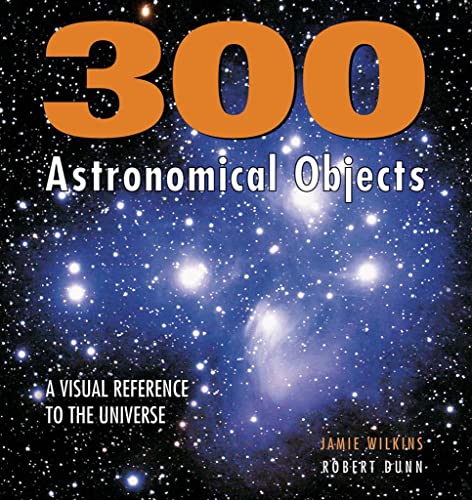
Synopsis
A handy and comprehensive reference to the 300 most interesting celestial objects.
This book provides a tour through the galaxy, from its solar core to its outer limits, with all the highlights and the very latest data about the universe.
Convenient data sidebars with each entry provide facts and figures on every object- including mass, magnitude, density, radius, rotation period, and surface and core temperatures. An annotated cross-section of the object enhances this information, and a full-page photograph brings the object to life.
Additional spreads bring together and explain related objects or phenomena. For example, the corresponding pages for the sun include solar power, sunspots and solar flares. Others examples include:
- Mercury: Mercury's surface
- The asteroid belt: Eros 433
- Jupiter's moons: 10, Europa, Callista
- Uranus: Uranus' rings, Ariel and Titania
- Outer belts and comets: Halley's comet; Deep Impact
- Space telescopes: International Space Station.
300 Astronomical Objects is a handy reference for the amateur astronomer.
"synopsis" may belong to another edition of this title.
About the Author
Jamie Wilkins has a degree in astrophysics from Cambridge University.
Robert Dunn has a degree in natural sciences, specializing in physics, from Cambridge University, where he is a researcher at the Institute of Astronomy.
"About this title" may belong to another edition of this title.
Other Popular Editions of the Same Title
Search results for 300 Astronomical Objects: A Visual Reference to the...
300 Astronomical Objects : A Visual Reference to the Universe
Seller: Better World Books: West, Reno, NV, U.S.A.
Condition: Good. Former library book; may include library markings. Used book that is in clean, average condition without any missing pages. Seller Inventory # 5302729-6
300 Astronomical Objects : A Visual Reference to the Universe
Seller: Better World Books, Mishawaka, IN, U.S.A.
Condition: Very Good. Former library book; may include library markings. Used book that is in excellent condition. May show signs of wear or have minor defects. Seller Inventory # 1408876-6
300 Astronomical Objects: A Visual Reference to the Universe (Firefly Visual Reference)
Seller: ThriftBooks-Dallas, Dallas, TX, U.S.A.
Hardcover. Condition: Good. No Jacket. Pages can have notes/highlighting. Spine may show signs of wear. ~ ThriftBooks: Read More, Spend Less. Seller Inventory # G1554071755I3N00
300 Astronomical Objects: A Visual Reference to the Universe (Firefly Visual Reference)
Seller: ThriftBooks-Atlanta, AUSTELL, GA, U.S.A.
Hardcover. Condition: Very Good. No Jacket. May have limited writing in cover pages. Pages are unmarked. ~ ThriftBooks: Read More, Spend Less. Seller Inventory # G1554071755I4N00
300 Astronomical Objects: A Visual Reference to the Universe (Firefly Visual Reference)
Seller: ThriftBooks-Dallas, Dallas, TX, U.S.A.
Hardcover. Condition: Very Good. No Jacket. May have limited writing in cover pages. Pages are unmarked. ~ ThriftBooks: Read More, Spend Less. Seller Inventory # G1554071755I4N00
300 Astronomical Objects: A Visual Reference to the Universe (Firefly Visual Reference)
Seller: HPB-Emerald, Dallas, TX, U.S.A.
hardcover. Condition: Very Good. Connecting readers with great books since 1972! Used books may not include companion materials, and may have some shelf wear or limited writing. We ship orders daily and Customer Service is our top priority! Seller Inventory # S_450129286
300 Astronomical Objects: A Visual Reference to the Universe (Firefly Visual Reference)
Seller: MusicMagpie, Stockport, United Kingdom
Condition: Very Good. 1762531051. 11/7/2025 3:57:31 PM. Seller Inventory # U9781554071753
Buy Used
Ships from United Kingdom to U.S.A.
Quantity: 1 available
300 Astronomical Objects: A Visual Reference to the Universe (Firefly Visual Reference)
Seller: AwesomeBooks, Wallingford, United Kingdom
Hardcover. Condition: Very Good. 300 Astronomical Objects: A Visual Reference to the Universe (Firefly Visual Reference) This book is in very good condition and will be shipped within 24 hours of ordering. The cover may have some limited signs of wear but the pages are clean, intact and the spine remains undamaged. This book has clearly been well maintained and looked after thus far. Money back guarantee if you are not satisfied. See all our books here, order more than 1 book and get discounted shipping. . Seller Inventory # 7719-9781554071753
Buy Used
Ships from United Kingdom to U.S.A.
Quantity: 1 available
300 Astronomical Objects: A Visual Reference to the Universe (Firefly Visual Reference)
Seller: Bahamut Media, Reading, United Kingdom
Hardcover. Condition: Very Good. Shipped within 24 hours from our UK warehouse. Clean, undamaged book with no damage to pages and minimal wear to the cover. Spine still tight, in very good condition. Remember if you are not happy, you are covered by our 100% money back guarantee. Seller Inventory # 6545-9781554071753
Buy Used
Ships from United Kingdom to U.S.A.
Quantity: 1 available
300 Astronomical Objects: A Visual Reference to the Universe (Firefly Visual Reference)
Seller: Toscana Books, AUSTIN, TX, U.S.A.
Hardcover. Condition: new. Excellent Condition.Excels in customer satisfaction, prompt replies, and quality checks. Seller Inventory # Scanned1554071755

